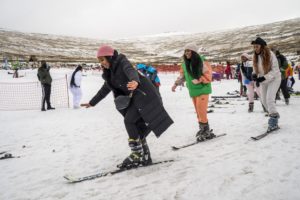NEW YORK — Two women who claim New York City police officers used excessive force and exhibited abusive behavior during their arrests at a march earlier this month after the death of George Floyd have lodged formal complaints with the city and say they intend to sue, the latest fallout here from law enforcement’s handling of protests demanding greater accountability for the police.
Destiny Strudwick and Yasmin Geurts were arrested, separately, in Brooklyn’s Williamsburg neighborhood during what they say was a peaceful demonstration the night of June 4, about 90 minutes after a citywide curfew had taken effect.
Bystander video obtained and authenticated by The Washington Post shows Strudwick, who is black, lying facedown on the pavement outside a cluster of homes. She can be heard screaming for help while surrounded by multiple officers as they attempt to restrain her. Moments later, one of the officers fires a Taser at her torso, striking her in the abdomen.
Geurts, who is white, alleges that she, too, was roughed up by officers and that a police supervisor made sexually suggestive comments to her when she complained of pain from the zip ties used to lash her hands behind her back.
Paul Prestia, the women’s attorney, said Strudwick and Geurts “were well within their rights to peacefully protest” that night. “However, the audacity of these police officers to impose their force on them was not right.”
An NYPD spokeswoman, Sgt. Jessica McRorie, acknowledged that officials are looking into the encounters, but she declined to comment further.
To date, more than 750 complaints stemming from the protests have been filed against the NYPD, according to New York City’s Civilian Complaint Review Board. The grievances cover 170 separate incidents, a spokesman for the independent agency said.
The New York State Attorney General’s Office is investigating the department’s enforcement actions throughout the protests here, part of a nationwide wave of demonstrations spurred by Floyd’s death in Minneapolis police custody on May 25. Separately, Mayor Bill de Blasio has vowed to expedite the disciplinary process against officers accused of using excessive force and to promote transparency by making such records available to the public.
“When people don’t think there’s going to be justice, how is there going to be trust?” the mayor said Wednesday. “So we have to restore trust, and the best way to restore trust is to show that the accountability is there. That the internal disciplinary process of the NYPD will be fast, will be fair, will be transparent.”
Strudwick, 26, appeared on the long-running reality TV show “[America’s Next Top Model](https://www.realitytvworld.com/news/exclusive-destiny-strudwick-talks-about-top-model-college-edition-(part-1)-13872.php)” in 2012. The Ohio native moved to New York last year and became friends with Geurts, 27, also a professional model. Geurts is from Minneapolis.
In an interview, Strudwick said she led the crowd demonstrating peacefully in Brooklyn on the night of their arrests, calling her brief stint as a protest organizer “empowering and really cool.”
The most popular and interesting stories of the day to keep you in the know. In your inbox, every day.
When Strudwick saw police closing in, she “screamed, ‘All white people get to the front — they don’t want to kill you,’ ” she said.
Video taken by Strudwick before her arrest shows her defying firm orders by an NYPD supervisor to “get back” and clear the area.
“Are you gonna hit me?” Strudwick shouted back.
She and Geurts had been separated during the march and she yelled out for her friend, she recalled. “I turned around for like a split second and that’s when I saw this like six-foot-like-five, like probably 300-pound black cop like run at me and tackle me,” Strudwick said. “And I fell to the ground . . . and I was, like, screaming. . . . I was just scared.”

She described the pain from being knocked to the street and Tasered as immense, saying she felt afraid “for my life and so I’m like squirming,” but “it was physically impossible for me to resist.”
The weight of the officer on top of her was crushing, she said, recalling the feeling of her eyes rolling back as the electricity from the Taser pulsed through her body.
Strudwick suffered shoulder and wrist injuries in the takedown, she said, noting that as she was being loaded into the police van, she told police that she couldn’t breathe; she claims that one officer called her suffering a “performance.”
Strudwick was taken to Woodhull Hospital in Brooklyn, where the Taser probes were removed from her abdomen. A doctor there told her he didn’t think any bones were broken, she said, and she was sent home with Advil. She still has bruises, scratches and scarring, she said.
“She was shaking and crying. It was like that until like six in the morning,” said Geurts, who went to Strudwick’s apartment after being released from custody after 1 a.m.
Geurts, who had bruises on her arms, was issued a summons for violation of curfew. Strudwick was cited for disorderly conduct and fighting. Both were ordered to appear in court at a later date.
The NYPD has been criticized for using the “kettling” technique to surround groups and make arrests throughout the city’s week-long curfew, which was put in place in response to widespread looting and violence spurred by the protests. Both women, and the man who shot the video of Strudwick’s arrest, Dan O’Halloran, described a kettling that night — police formations encircling hundreds of marchers.
O’Halloran, who works for the New York City Health Department, said he and his wife attended the march and were terrified by the police response and the stampede of participants that ensued. He and his wife took cover on a stoop just a few feet from the encounter, he said, adding that he wanted to help Strudwick but believed that if they tried to do so, “we would have had the same fate.”
“My motivation was to continue filming, to try to document what was happening,” O’Hallaron said, “because I knew it was wrong.”




